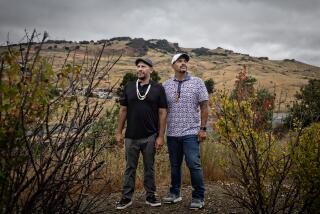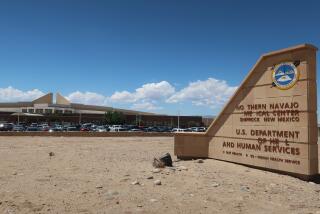Words of Praise for Navajo Code Talkers’ Heroics : Remembrances: Their native language was used to relay orders during World War II. They are honored as part of many Veterans Day ceremonies.
- Share via
FLAGSTAFF, Ariz. — Amid the din and confusion of the bloodiest and most crucial battles of World War II, the U.S. Marine Corps had a secret weapon: the Navajo code talkers.
Navajos from the Southwest formed an elite communications unit that, by speaking a coded version of their native language, allowed combat troops in the Pacific to relay messages quickly, accurately and with total assurance that the enemy could not understand them.
Military historians, aware that information can be as decisive as weaponry during battle, have long praised the Navajo code talkers’ role in the Pacific campaign. The code talkers make no such claims.
“We never thought we were special; we were just Marines doing our job,” said Carl Gorman, 88, one of 25 code talkers who assembled in Flagstaff on Saturday for a Veterans Day ceremony in their honor at Northern Arizona University, one of many held across the country.
Southland events included the dedication in Los Angeles of a memorial to Japanese Americans killed fighting the Vietnam War and erection of 919 flags at Memory Garden Cemetery in Brea.
In San Francisco, dignitaries, art lovers and veterans gathered to reopen the California Palace of the Legion of Honor, an art museum designed to honor the 3,600 Californians who died in World War I. The building had been closed for three years for seismic reinforcement and remodeling. Across the bay, Country Joe McDonald, a stalwart Vietnam War protester, led a memorial service in Berkeley to honor 22 local men lost during the Vietnam War.
The highlight of the Arizona ceremony on a sunny day at the university campus was the unveiling of a bust of Gorman sculpted by his son, noted artist R.C. Gorman, as a tribute to all Navajo code talkers.
Marine Col. Willis Hansen, representing the Marine commandant, Gen. Charles Krulak, called the sculpture “a long overdue monument to the dedication and bravery of a unique group of Americans.”
Of the many codes used by the U.S. military during World War II, the Navajo code was one that could not be broken by the Japanese and their master cryptographers.
With the Navajo code talkers, the Marines at Guadalcanal, Tarawa, Saipan, Iwo Jima and Okinawa were able to maintain an element of surprise and to save American lives that might have been lost if the Japanese had been able to break the code being used to coordinate the American assault.
On Iwo Jima, it was a Navajo code talker who relayed the joyous message that Marines had finally raised the American flag on Mt. Suribachi.
Hansen, commanding officer at the Marine air station in Yuma, said that a Marine major later told his superiors that “if it were not for the Navajos we would not have taken Iwo Jima.”
Merril Sandoval, 70, remembered a three-day stretch when fighting was the heaviest and Navajo code talkers were used to communicate between platoons that found Japanese resistance much fiercer than the Marines had expected.
“Messages, messages, messages,” Sandoval remembered. “The Marines were moving and moving. We knew our buddies depended on us to get the information right. We did it. Not a single mistake in any message.”
The Navajo code talkers were mostly assigned to advancing rifle companies. Harry Benally, 69, landed on Okinawa in one of the first waves and, between sending coded messages, captured and disarmed 14 of the enemy.
“You did what you had to do,” Benally said.
So important were the Navajo code talkers that for nearly 25 years the military kept their role a secret, lest it be needed again during wartime. The Navajos were warned never to mention, even to their families, what they had done during the war.
“We were told just to say we were in the war,” said Samuel Billison, 70, president of the code talkers association. “That was all right. We weren’t looking for glory.”
In 1969, the Marine Corps relented, and slowly the honors that had been denied them began to accrue to the Navajo code talkers, who served in all six Marine divisions.
President Ronald Reagan issued a proclamation praising the code talkers, the Pentagon held a photographic exhibit, a code talker contingent marched in the Rose Parade, and reunions were held at Marine Corps bases.
The sculpture of Carl Gorman--a four-foot bronze bust mounted on an eight-foot sandstone pedestal--was a gift to Northern Arizona University from R.C. Gorman, an NAU graduate. A plaque lists the names of the original code talkers.
“I chose to model a bust after my father because he has such a strong face,” Gorman said. His father is an artist and retired teacher.
It is fitting that the code talker memorial be located here. NAU has 1,200 Native American students--700 of them Navajo--and offers a full range of classes on Native American culture, including one of the few classes at any university on the Navajo language.
Speaking to more than 400 people at the ceremony, Albert Hale, president of the Navajo Nation, praised the code talkers for giving to the war effort “a portion of your culture, a portion of your language . . . a language that was given to us by the Holy People when we were placed between the four sacred mountains.”
During what military historians call “the fog of battle,” communications often became garbled. A fighting force that cannot communicate can quickly become lost and vulnerable.
The Japanese were experts at intercepting communications over walkie-talkies and telephone lines and then, using English-speaking Japanese soldiers, sending out bogus communications to confuse the American troops or lure them into ambushes.
The idea to use Navajos as communication specialists came from a Los Angeles engineer and former Marine named Philip Johnston, the son of missionaries who lived on a Navajo reservation. The fit was a good one because the Navajos have a long history of serving in the U.S. military.
With its guttural sounds and complex tonal distinctions, the Navajo language is difficult even for Navajos to learn. It was an unwritten language and virtually unknown outside the Navajo world, and linguists said that it was nearly impossible for someone to learn Navajo except by immediate immersion as a child.
The original 30 Navajo code talkers, including Gorman, trained at the Marine Corps Recruit Depot in San Diego, Camp Pendleton and the now-defunct communications school at Camp Elliott in San Diego.
In all, 300 code talkers saw combat duty and 11 were killed. Code talkers were prepared to commit suicide if captured rather than disclose any information.
Today, battlefield communication is accomplished by satellites, scrambling devices and other cutting-edge electronic wizardry. By comparison, communication in the early stages of World War II was primitive.
Messages could take hours to code, relay and decode, thus sometimes making them useless. There was no such thing as a secure radio line for communication between forward units and commanders at the rear. The enemy heard everything.
The Navajo code talkers devised a code of 211 words and a word for each of the 26 letters when spelling was necessary. For many military terms, there was no Navajo equivalent, so lo-tso , or whale, was used for battleship, for example.
“After the war, most of us forgot about code talking because we weren’t allowed to speak about it,” said Clifford Buck, 69. “But now it is good what is happening. It is important to remember.”
More to Read
Sign up for Essential California
The most important California stories and recommendations in your inbox every morning.
You may occasionally receive promotional content from the Los Angeles Times.










